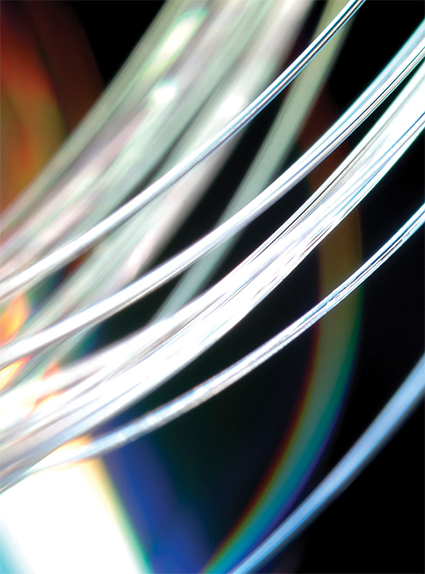Building cabling systems can be roughly divided into three categories: the workstation cabling, the building backbone, and the campus backbone. The workstation cabling, also called horizontal cabling, is usually implemented using twisted-pair cabling (copper cabling), while the vertical building backbone and campus backbone are domains of fiber optic cabling. Kannegieter offers a suitable cabling concept for every application, including prefabrication of cables and connectors.


Cabling to workstations and equipment is mostly done using twisted-pair cabling. This copper cabling is divided into various categories (Cat5e, Cat6, Cat6a, Cat7, Cat7a, and Cat8), which indicate the cable’s maximum data rate. Additionally, the categories specify the amount of data (bandwidth) that can be sent and received at any given time. While Cat5e cables can achieve speeds up to 1000 Mbit/s and have a bandwidth of 100 MHz, Cat8 cables can reach speeds of 40 Gb/s and have bandwidths of 2 GHz (2000 MHz)! This makes Cat8 copper cabling ideal for computer rooms and medium-sized data centers. Cat5e is more suitable for smaller (home) networks, which are now migrating to at least Cat6.
Kannegieter provides cabling concepts ranging from category Cat5e to Cat8. We distinguish between Unshielded twisted pair (UTP) and Shielded twisted pair (STP) cables, with STP cables preventing electromagnetic interference (EMI) as much as possible. Our concepts are suitable for all common switchgear and can be delivered with a fixed or modular patch panel as desired. This ensures a professional, flexible, and certified cabling network that meets your communication needs exactly.
For the building or campus backbone (vertical cabling), the use of fiber optic cabling is generally recommended. Two groups are distinguished: Single-Mode (SM) and Multi-Mode (MM). The main differences between these groups are the fiber core diameter, the way light propagates in the cables, and the number of fibers required to establish a connection. Multi-Mode cables are mainly used to bridge distances up to 3 km and are therefore excellent for building backbones. The cables can be divided into the Optical Multimode (OM) types OM1, OM2, OM3, OM4, and OM5. The larger the number, the greater the speed, bandwidth, and transmission distance. For newly installed systems, we recommend using OM3 and OM4, while OM5 is primarily intended for large data centers with specific applications.
Single-Mode (OS2) cables can easily bridge distances of more than 40 km and are therefore an excellent solution for the campus backbone or beyond. As optical SM equipment becomes cheaper, we also see growing interest in Single-Mode building backbones. At Kannegieter, we naturally go along with this. Based on your situation, connectivity needs, and budget, we would be happy to inventory the most suitable cabling concept.
When installing fiber optic cabling, installers have two options: the traditional method of laying, terminating, and testing fiber optic cables, or the modern method using conduit. In the latter case, the conduit infrastructure is installed first, into which individual fiber strands or fiber optic cables are blown later. The great advantage of this method is its flexibility. Because multiple fiber strands or fiber optic cables can be blown into one conduit, capacity problems can be quickly and easily resolved without disruption. Additionally, MM and SM cables can be easily swapped as capacity needs change. Kannegieter supplies both conduit, blown fiber, and blown fiber cables for this purpose.


Space is money, which is why it’s important to optimize every square meter of MER, SER, or data center space. One way to do this is by maximizing the number of fiber optic connection points per square meter. Kannegieter offers High-Density patch panels in addition to standard solutions. Our High-Density solutions are characterized by high port density and minimal space requirements, allowing you to mount even more active equipment in your patch cabinets.
To reduce the risks of fire in buildings, the European Construction Products Regulation (CPR) has been mandatory since 2017. This regulation classifies the fire behavior according to various Euro classes, which provide insight into the fire propagation, smoke development, heat release, burning droplets, and corrosivity/acidity of network cables. In the Netherlands, the NEN 8012 has been established for this purpose, which is limited to the B2ca, Cca, Dca, and Eca classifications. Kannegieter’s network cables comply with these CPR classifications, and the Declaration of Performance (DoP) performance statement is available per product upon request.

Astronaut 28
3824 MJ Amersfoort
+31 (0)33 450 86 86